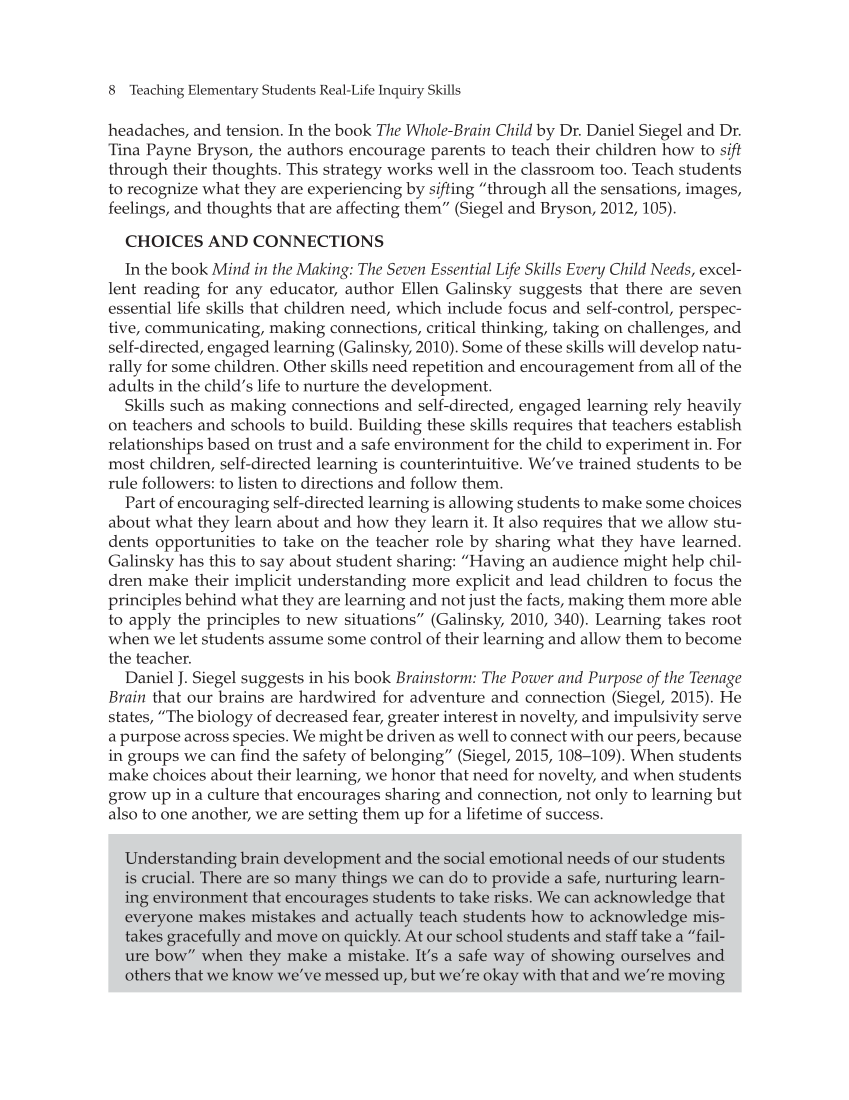Teaching Elementary Students Real-Life Inquiry Skills 8 headaches, and tension. In the book The Whole-Brain Child by Dr. Daniel Siegel and Dr. Tina Payne Bryson, the authors encourage parents to teach their children how to sift through their thoughts. This strategy works well in the classroom too. Teach students to recognize what they are experiencing by sifting “through all the sensations, images, feelings, and thoughts that are affecting them” (Siegel and Bryson, 2012, 105). CHOICES AND CONNECTIONS In the book Mind in the Making: The Seven Essential Life Skills Every Child Needs, excel- lent reading for any educator, author Ellen Galinsky suggests that there are seven essential life skills that children need, which include focus and self-control, perspec- tive, communicating, making connections, critical thinking, taking on challenges, and self-directed, engaged learning (Galinsky, 2010). Some of these skills will develop natu- rally for some children. Other skills need repetition and encouragement from all of the adults in the child’s life to nurture the development. Skills such as making connections and self-directed, engaged learning rely heavily on teachers and schools to build. Building these skills requires that teachers establish relationships based on trust and a safe environment for the child to experiment in. For most children, self-directed learning is counterintuitive. We’ve trained students to be rule followers: to listen to directions and follow them. Part of encouraging self-directed learning is allowing students to make some choices about what they learn about and how they learn it. It also requires that we allow stu- dents opportunities to take on the teacher role by sharing what they have learned. Galinsky has this to say about student sharing: “Having an audience might help chil- dren make their implicit understanding more explicit and lead children to focus the principles behind what they are learning and not just the facts, making them more able to apply the principles to new situations” (Galinsky, 2010, 340). Learning takes root when we let students assume some control of their learning and allow them to become the teacher. Daniel J. Siegel suggests in his book Brainstorm: The Power and Purpose of the Teenage Brain that our brains are hardwired for adventure and connection (Siegel, 2015). He states, “The biology of decreased fear, greater interest in novelty, and impulsivity serve a purpose across species. We might be driven as well to connect with our peers, because in groups we can find the safety of belonging” (Siegel, 2015, 108–109). When students make choices about their learning, we honor that need for novelty, and when students grow up in a culture that encourages sharing and connection, not only to learning but also to one another, we are setting them up for a lifetime of success. Understanding brain development and the social emotional needs of our students is crucial. There are so many things we can do to provide a safe, nurturing learn- ing environment that encourages students to take risks. We can acknowledge that everyone makes mistakes and actually teach students how to acknowledge mis- takes gracefully and move on quickly. At our school students and staff take a “fail- ure bow” when they make a mistake. It’s a safe way of showing ourselves and others that we know we’ve messed up, but we’re okay with that and we’re moving
Document Details My Account Print multiple pages
Print
You have printed 0 times in the last 24 hours.
Your print count will reset on at .
You may print 0 more time(s) before then.
You may print a maximum of 0 pages at a time.

























































































































































































